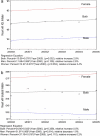Basic ADL disability and functional limitation rates among older AMERICANS from 2000-2005: the end of the decline?
- PMID: 19723771
- PMCID: PMC2781786
- DOI: 10.1093/gerona/glp130
Basic ADL disability and functional limitation rates among older AMERICANS from 2000-2005: the end of the decline?
Abstract
Background: This study sought to determine whether the rates of basic activities of daily living (ADL) disabilities and functional limitations declined, remained the same, or increased between 2000 and 2005 when (a) only community-dwelling Americans aged 65 and older were examined and (b) when institutionalized older adults were included.
Method: Using data from the American Community Survey and the National Nursing Home Survey, we calculated annual prevalence rates of basic ADL disabilities and functional limitations and fitted regression lines to examine trends over time.
Results: The rates of basic ADL disabilities among community-dwelling adults aged 65 and older increased 9% between 2000 and 2005. When institutionalized elders were included, basic ADL disability rates were stable among men but increased among women. Functional limitation rates did not significantly change between 2000 and 2005.
Conclusion: These findings suggest an end of the decline in disability rates among older Americans, which, if confirmed, could have important implications for health care.
Figures


Comment in
-
Challenges in estimating trends in late-life disability from the American Community Survey.J Gerontol A Biol Sci Med Sci. 2010 May;65(5):517-8. doi: 10.1093/gerona/glp218. Epub 2010 Jan 20. J Gerontol A Biol Sci Med Sci. 2010. PMID: 20089667 Free PMC article. No abstract available.
-
Unadjusted prevalence rates: why they still matter for older adults' disability rates.J Gerontol A Biol Sci Med Sci. 2010 May;65(5):545-6. doi: 10.1093/gerona/glq031. Epub 2010 Mar 15. J Gerontol A Biol Sci Med Sci. 2010. PMID: 20231215 No abstract available.
References
-
- Freedman VA, Martin LG, Schoeni RF. Recent trends in disability and functioning among older Americans: a critical review of evidence. JAMA. 2002;288:3137–3146. - PubMed
-
- Freedman VA, Crimmins EM, Schoeni RF, et al. Resolving inconsistencies in trends in old age disability: report from a technical working group. Demography. 2004;41:417–441. - PubMed
-
- Crimmins EM, Saito Y, Reynolds SL. Further evidence on recent trends in the prevalence and incidence of disability among older Americans from two sources: the LSOA and the NHIS. J Gerontol A Biol Sci Med Sci. 1997;52B:S59–S71. - PubMed
-
- Schoeni RF, Freedman VA, Wallace R. Persistent, consistent, widespread, and robust? Another look at recent trends in old-age disability. J Gerontol A Biol Sci Med Sci. 2001;56B:S206–S218. - PubMed

